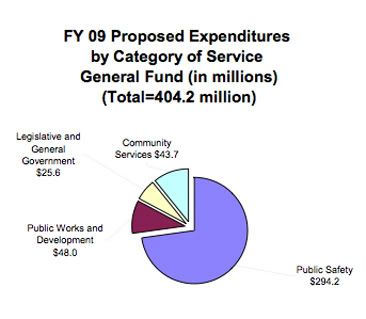
The Fiscal Year 2009 City Budget was proudly displayed by City Manager Pat West and Mayor Bob Foster last week, a culmination of West’s hard work and organization in putting together a massive binder that amounted to fiscal responsibility, and Foster’s dedication to providing core City services while simultaneously cutting costs.
Oh, and did I mention, managing to save the city from a $17 million deficit?
They knew it was coming and were able to prepare for it, a big red mark at the end of Fiscal Year 2008 that must have haunted dreams for months. But emphasizing Mayor Foster’s recent “One City” campaign and convincing city departments to think not of their own needs but of those of Long Beach, costs have been cut while in some areas, public service will actually improve.
For one example, the Mayor and this budget (which is available to view here) depend mightily on the Harbor Department, one of the many “non-City Manager” departments that Foster and West are counting on to improve service during financial hardship. Mayor Foster is requesting that the Department excuse $27 million owed from the city for expansions to the Long Beach Convention Center in order to save money for the city. At the same time, he looks for the Department to become a more active community leader, suggesting that they host the municipal band and Midnight Basketball program – which may otherwise cease to exist.
Mayor Foster and Manager West are aware that they’re asking a lot of local services, but that was the point. Both painted a picture of past city government spending that contributed to, not eased, budget woes. They now seek to streamline city services, which means cutting costs and in some cases, cutting jobs or programs. But quality of service will not be sacrificed, as the Mayor spoke excitedly about continuing to crack down on graffiti and purchasing three new trucks for fixing potholes.
Shown below are figures representing all proposed 2009 expenditures. Here is how the $3.1 billion will break down:

Subsidiary Funds – $1.231 billion
(Redevelopment Agency, Harbor Department, Housing Authority + more)
Enterprise Funds – $409.8 million
(Gas & Oil, Long Beach Airport + more)
Tidelands Funds – $494.2 million
Thanks to oil revenues, this figure is “much more significant than we’ve had in the past,” says City Manager West.
Internal Service Funds – $337.1 million
(Benefits, employees + more)
Special Funds – $214.2 million
(Capital projects, development services, Health Department + more)
General Fund – $404.2 million
Below are the expenditures for the General Fund, which is expected to come out to $404.2 million:

Police – 47.8%
Fire – 18.1%
Community Development – 1.4%
Citywide Activities – 4.9%
Other City Manager Departments – 5.1%
Non-City Manager Departments – 5.4%
Library Services – 3.1%
Public Works – 7.7%
Parks, Recreation & Marine – 6.3%
You’ll notice that nearly half of all general fund expenditures will go to the Long Beach Police Department. This may seem unusually high, but Mayor Foster commended Chief Tony Batts again and again for his cooperation in finding ways to cut costs and save money. As previously mentioned when the story first broke, one of those ways is cutting the Police Athletic League, a police-run youth program to keep kids involved in sports. Eliminating the program saves money and instantly allows six officers to return to duty, but cuts a vital program that many in the city had turned to as an outlet. Nevertheless, the LBPD is another area which will cut costs but not suffer in quality, and the city intends to maintain a force of about 1,020 and provide for 14 new officers under Proposition H.
“Unless we cut $10 million from the Police Department, we would’ve ended this year (2008) in the red,” said Mayor Foster, referring to PAL. “I can’t tell you how disappointed we all are to have to do this. It’s not a happy day.”
Additionally, reworking employee healthcare costs will save between an estimated $1 million and $1.5 million from expenditures, and selected services will be outsourced to private companies that are able to work for competitive pricing rather than using a more expensive designated city service (building trades, security services, fleet services, etc.).
It’s all a part of Foster’s mission, encouraging city employees and departments to think not of themselves, but of the effect that they have on their surrounding communities and fellow departments. Many will take financial hits in order to provide for others, while some will lose employees who were sacrificed for a balanced budget. But something had to be done, and soon. Long Beach Director of Financial Management, Lori Ann Farrell, added this statement in a release:
“We are at a critical point where the fiscal strength of the city will be determined by a well-designed strategy to ensure true structural balance. Although Long Beach benefits from a diverse funding base, this advantage can only help so much without implementing other calculated measures to control costs and streamline operations.”
Something had to be done to fix Long Beach’s budget woes before they spun wildly out of control, and while the proposed 2009 budget will sharply cut some department’s budgets and eliminate important programs, this is a plan not only for 2009 but for many years beyond, as Long Beach looks with hopeful eyes towards a future of fiscal responsibility.
By Ryan ZumMallen, Managing Editor
